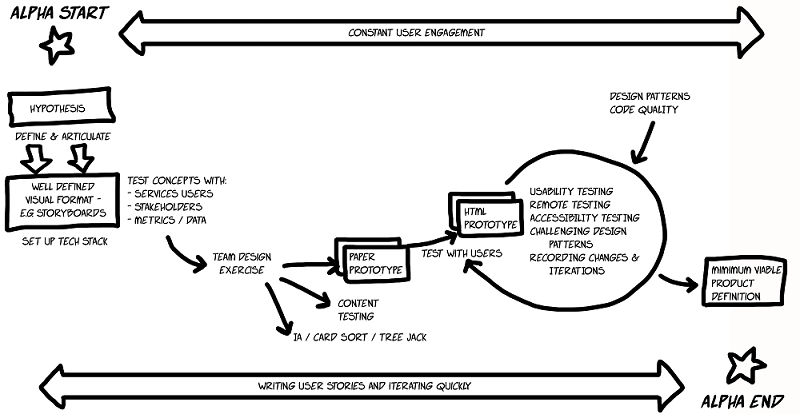Alpha phase research
Alpha is an experimental phase. It's an opportunity to check if you are building the right thing, before you go ahead and start building a working service.

Source: 1.1. What is Alpha?
It's the second stage of the service design and delivery process. During Alpha, you test the hypothesis you formulated in the Discovery phase. You build prototypes in code and explore different ways of meeting your users' needs.
The aim of user research in Alpha is to improve the team's understanding of users and their needs. You test different design ideas and prototypes, and learn how to develop a solution that helps users achieve their goal.
Alpha phase research should explore multiple ideas. Do user research to learn which approach works best and iterate your solution as you learn more and should to include the following mix of participants:
- end users and public servants delivering the service
- people with disabilities
- people for whom English is a second language
- people with limited internet access
- those who may need assistance to interact digitally or are unable to interact digitally at all.
Typical Alpha user research activities
- Interviews and focus groups to deepen your understanding of relevant aspects of users' lives and work
- Testing design concepts with likely users to see how well they meet user needs
- Testing interactive prototypes to explore usability of different designs.
Keep in mind when recruiting participants with disabilities, it might not be possible to test:
- paper prototypes with users who are blind or partially sighted
- prototype code with people who use assistive technologies such as screen readers or speech recognition software. You can do this in Beta when you start working with production code.
From these research activities, you'll typically get:
- a better understanding of user needs including their support and access requirements
- feedback on how well your designs work for users
- helpful insight into usability issues related to layout, functionality and content.
You'll have done enough research when you're confident you've identified a design solution/prototype that meet your users' needs - including those with disabilities and other potential barriers.